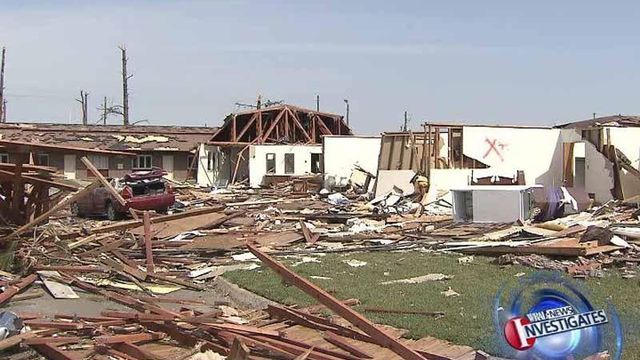FEMA gets mixed reviews three months after NC tornadoes
Three months after tornadoes tore across North Carolina, killing 24 people, FEMA has taken more than 9,700 applications for grants and loans and approved more than $18 million in assistance. However, the WRAL Investigates team found that most people don't qualify for help.
Posted — UpdatedHowever, WRAL Investigates found that most people don’t qualify for help.
The Federal Emergency Management Agency approved assistance for 2,205 applicants, or nearly 23 percent.
Rejection was based on many factors, including whether insurance covered losses, whether a home was livable and whether the applicant finished paperwork necessary to apply for FEMA aid.
Every storm victim has a story and varying opinions of FEMA's response. WRAL Investigates spent several days going door to door in four area counties to hear first hand from those who dealt with the agency.
“I lost 37 years of my life in just a matter of seconds,” said Lee County farmer Steve Thomas, who estimates he suffered $3 million in damage to buildings and equipment.
Insurance covered about a third, according to Thomas, who says a FEMA representative urged him to apply for a federal Small Business Administration loan.
“I'm not asking for any free money. I'm just asking for a loan to help me back,” he said.
Yet, by law, agriculture losses aren't eligible for SBA loans. Thomas is now struggling to find other options.
“Something's wrong somewhere in the paper trail. They shouldn't have sent a man here twice and wasted my time on two occasion," Thomas said. "And then (I) get a phone call, ‘Well, you don't qualify. Somebody should have told you that before.'"
Days after the April 16 storm, WRAL News met victims whose homes were condemned by local authorities. Yet FEMA deemed them livable.
“I'm sure once or twice or some number of times there's going to be mistakes,” said Mike Bolch, federal coordinating officer for FEMA in North Carolina
Bolch and state Emergency Management Director Doug Hoell led the federal and state recovery efforts in North Carolina. They wouldn’t talk about specific cases, but admit it's a complicated process handling thousands of aid requests, especially when emotion meets bureaucracy.
“A lot of people like to have themselves made whole, but it's really up to an individual, their insurance, their family, their savings,” Bolch said.
Weeks after the storm, FEMA gave Tanya Nava’s family $8,000. Her uninsured home in Micro was a pile of rubble.
“I'm not a greedy person. You get what you get and be happy with it, but it wasn't enough to put us in another place,” Nava said.
Across town, Tammy Johnson's family, also uninsured, fared better. She received the maximum $30,000 in assistance to buy a used mobile home to replace her demolished one.
“FEMA has been great. They've come through. They've helped us out, and that's how we have what we have now,” Johnson said.
Despite a gaping hole in her Raleigh roof, Susan Allen was rejected by FEMA because she didn't have to leave her home. She was frustrated, she said, until volunteers from the North Carolina Baptist men showed up to replace her steps.
“I really thought they (FEMA) were going to help me. But then, as it turned out, they didn't,” Allen said. “(The North Carolina Baptist men) said, ‘Don't worry about it. We will take care of your roof, too,’ and I cried.”
WRAL News found many volunteer efforts, like the First Baptist Church in Micro, picking up where taxpayer-funded response left off.
“All of that is part of the response. It is the whole community. It's not just state response or FEMA response,” Hoell said.
One common complaint WRAL News heard is that FEMA didn't move fast enough. Nava says she and her teenaged children slept in a car for days.
“When this happened, you need immediate help. You need it now, and they weren't here,” she said.
In Fayetteville, James Moore echoed that criticism.
“They did not do anything for me, more than hand me a piece of paper,” he said. “When people (are) in a disaster, they need help now, not tomorrow. They need help today.”
Still living in a travel trailer in his front yard, Moore is relying on insurance to repair his storm-battered house. He said he expected FEMA to provide immediate food and temporary housing help for his ravaged neighborhood.
Bolch says FEMA's role is to come days later to back up local- and state-led response.
“Some people's expectations are jaded like that. They think things can happen fast. Like I said, there's a lot of programs. We are the federal government, and we're working as diligently as we can to make that assistance available,” Bolch said.
In the end, FEMA sees its role in transitional housing and support after a disaster, not to make people whole again.
As of July 7, FEMA has provided the following assistance to people in North Carolina:
- More than $5.3 million from FEMA's Individual and Household Program for temporary housing and home repairs.
- Nearly $2.1 million in Other Needs Assistance, a joint state-federal program to help people replace personal property and pay for certain other disaster-related needs not covered by insurance or other federal, state and charitable aid programs.
- More than $11.2 million in SBA low-interest disaster loans for homeowners, renters and businesses.
In other figures:
- Nearly 6,200 homes have been inspected.
- Thirty-six temporary housing units supplied by FEMA are occupied in counties where rental resources are scarce.
- More than 5,100 SBA disaster loan applications have been sent out, of which more than 900 have been returned to SBA.
• Credits
Copyright 2024 by Capitol Broadcasting Company. All rights reserved. This material may not be published, broadcast, rewritten or redistributed.






